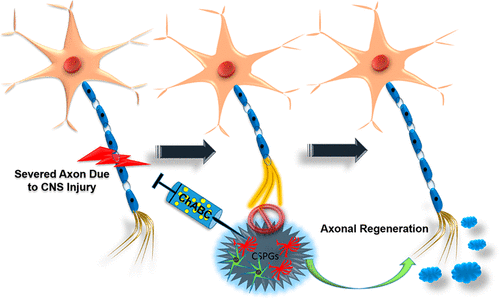当前位置:
X-MOL 学术
›
ACS Chem. Neurosci.
›
论文详情
Our official English website, www.x-mol.net, welcomes your feedback! (Note: you will need to create a separate account there.)
Targeting Chondroitin Sulfate Proteoglycans: An Emerging Therapeutic Strategy to Treat CNS Injury.
ACS Chemical Neuroscience ( IF 5 ) Pub Date : 2020-01-15 , DOI: 10.1021/acschemneuro.0c00004 Nabanita Mukherjee 1 , Subhadra Nandi 1 , Shubham Garg 1 , Satyajit Ghosh 1 , Surojit Ghosh 1 , Ramkamal Samat 1 , Surajit Ghosh 1
ACS Chemical Neuroscience ( IF 5 ) Pub Date : 2020-01-15 , DOI: 10.1021/acschemneuro.0c00004 Nabanita Mukherjee 1 , Subhadra Nandi 1 , Shubham Garg 1 , Satyajit Ghosh 1 , Surojit Ghosh 1 , Ramkamal Samat 1 , Surajit Ghosh 1
Affiliation

|
Chondroitin sulfate proteoglycans (CSPGs) are the most abundant components of glial scar formed after severe traumatic brain injury as well as spinal cord injury and play a crucial inhibitory role in axonal regeneration by selective contraction of filopodia of the growth cone of sprouting neurites. Healing of central nervous system (CNS) injury requires degradation of the glycosamine glycan backbone of CSPGs in order to reduce the inhibitory effect of the CSPG layer. The key focus of this Viewpoint is to address a few important regenerative approaches useful for overcoming the inhibitory barrier caused by chondroitin sulfate proteoglycans.
中文翻译:

针对硫酸软骨素蛋白聚糖:一种新兴的治疗策略,治疗中枢神经系统损伤。
硫酸软骨素蛋白聚糖(CSPG)是严重的颅脑损伤和脊髓损伤后形成的神经胶质瘢痕的最丰富成分,并且通过发芽神经突生长锥的丝状伪足的选择性收缩在轴突再生中起关键的抑制作用。中枢神经系统(CNS)损伤的愈合需要降解CSPG的糖胺聚糖骨架,以降低CSPG层的抑制作用。该观点的重点是解决一些重要的再生方法,这些方法可用于克服硫酸软骨素蛋白聚糖引起的抑制性障碍。
更新日期:2020-01-15
中文翻译:

针对硫酸软骨素蛋白聚糖:一种新兴的治疗策略,治疗中枢神经系统损伤。
硫酸软骨素蛋白聚糖(CSPG)是严重的颅脑损伤和脊髓损伤后形成的神经胶质瘢痕的最丰富成分,并且通过发芽神经突生长锥的丝状伪足的选择性收缩在轴突再生中起关键的抑制作用。中枢神经系统(CNS)损伤的愈合需要降解CSPG的糖胺聚糖骨架,以降低CSPG层的抑制作用。该观点的重点是解决一些重要的再生方法,这些方法可用于克服硫酸软骨素蛋白聚糖引起的抑制性障碍。

























 京公网安备 11010802027423号
京公网安备 11010802027423号